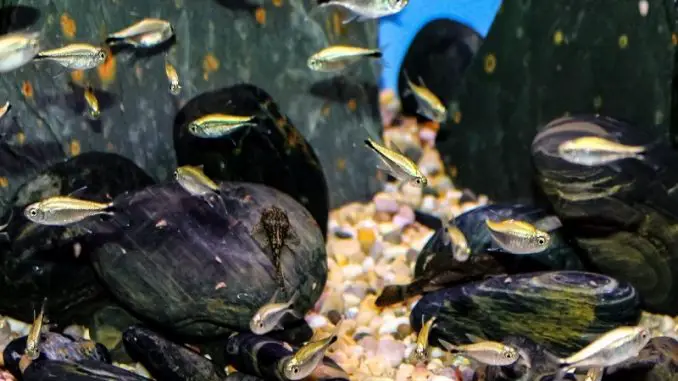
Gold tetras, of the greater tetra fish family, are really lovely to look at, even though many of them are not gold at all, but silver. Even the silvery grey specimens are beautiful, with an iridescent glow that sometimes says blue and sometimes says green.
Since they travel in shoals of 6 or more, you will likely see some color variety. If you are fortunate enough to get a golden Gold Tetra, you’ll know that it came from the wild and was exposed to a parasite called trematode. The gold color comes from the Gold Tetra’s body defensive response, and will not be present in captive-bred Gold Tetras, nor in the offspring of wild-born Gold Tetras.
These small fish can be handled by the beginning enthusiast, but they are more susceptible to skin conditions than some other aquarium fish. For this reason, I don’t rule them out for beginners, but acknowledge that these beauties might be a better fit for an intermediate hobbyist.
Even though they are only about 1 ½ inches, you will need a larger tank (at least 20 gallons) since you’ll be hosting at least 6 to keep them happy and secure in their shoal.
I highly recommend these shy little fish for your community aquarium. They are fun to watch and relatively easy to care for.
In this article, I’ll discuss everything you need to know about Gold Tetras. I’ll discuss some background, breeding requirements, dietary needs, health concerns, and what you need to offer them an appropriate habitat in which they will thrive.
TABLE OF CONTENTS
Gold Tetra Facts & Overview
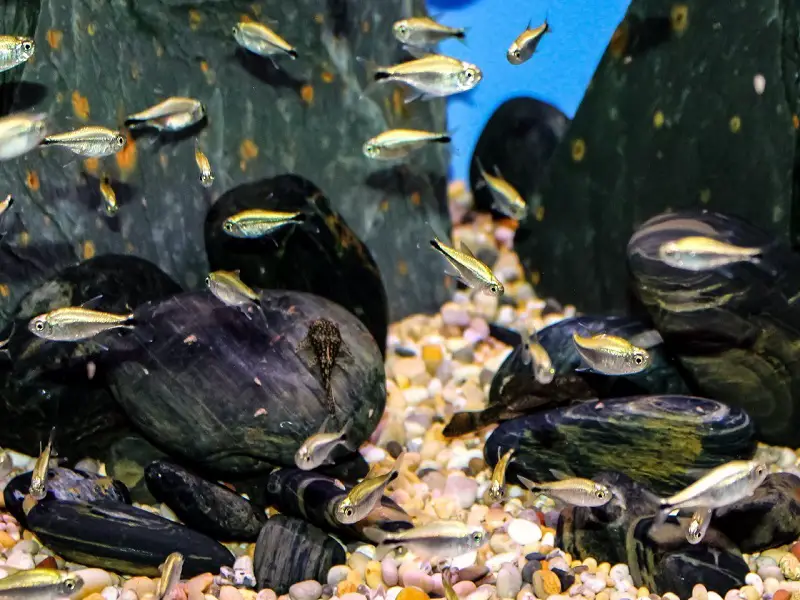
| Category | Rating |
| Care Level: | Beginner to intermediate |
| Temperament: | Peaceful |
| Color Form: | Black, gold, silver, yellow |
| Lifespan: | 3-4 years |
| Size: | 1.5 inches |
| Diet: | Omnivore |
| Family: | Characidae |
| Minimum Tank Size: | 20 gallons |
| Tank Set-Up: | Freshwater with driftwood |
| Compatibility: | Peaceful community |
Gold Tetras are native to the South American coast, specifically in the creeks, floodplains, rivers, and tributaries of Brazil, French Guiana, Guyana, Peru, and Suriname.
Their varied coloring has been a source of confusion for taxonomists. Gold Tetras, scientific name Hemigrammus rodwayi, are naturally not gold at all, but silver-grey. They do have some colors in their fins (black, red, gold, white), but their bodies are definitely a silverish grey.
In some parts of their natural habitat, however, Gold Tetras are exposed to the trematode parasite, which is dangerous to them. The presence of the trematode is the catalyst for a skin reaction in the fish in which spots of guanin, which protects them from the parasite, create a lovely gold color.
When scientists first discovered this golden hue, they assigned the gold Hemigrammus rodwayi to a new species but were mistaken. So if you hear Gold Tetras being referred to as Hemigrammus armstrongi, rest assured it is the same fish. Hemigrammus armstrongi is considered a synonym for Hemigrammus rodwayi.
That also means that you might get a Gold Tetra (also known as Golden Tetra or Brass Tetra) that isn’t gold at all. And if you are breeding in captivity, your Gold Tetras will definitely be silvery grey.
Gold Tetras are a type of Characins, which are one of the largest groups of aquarium fish. There are approximately 1,674 species of Characins.
Typical Behavior
Gold Tetras are very peaceful and shy. They are not at all aggressive. As they are slow swimmers and can easily be beaten to food, you’ll have to make sure that they are getting enough food.
Gold Tetras get anxious when there is too much activity or if they hear loud noises, so you should be mindful about where you place the aquarium.
Also known as X-Ray Tetras because of their bone structure, Gold Tetras pick up sound waves through their bone structure, so they have excellent hearing.
You can expect your Gold Tetras to live 3-4 years in your community aquarium; in the wild, they can live up to 5 years.
Appearance
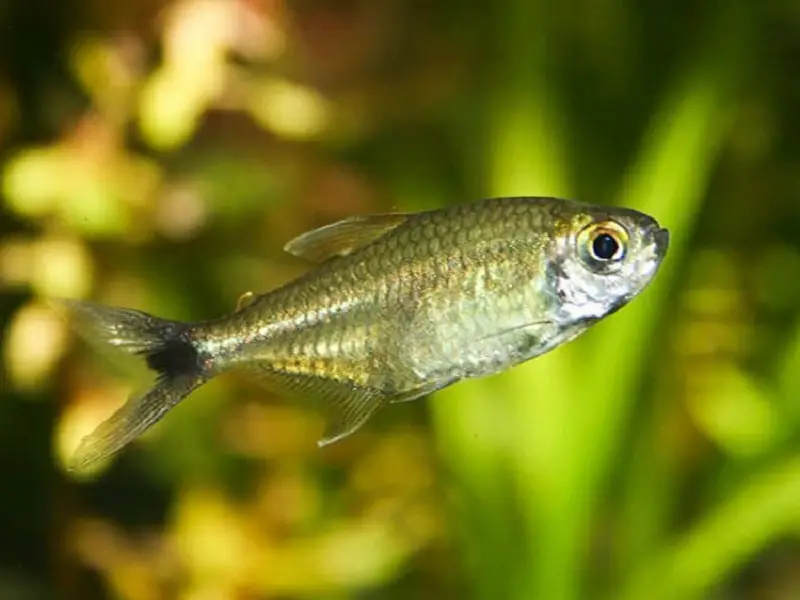
Gold Tetras are named for the protective secretion, guanin, which provides their silver bodies with a golden hue. In captivity, Gold Tetras reach about 1 ½ inches (4 cm); they get a little larger in the wild.
In addition to the gold dust coloring, Gold Tetras have a tail fin that has a black spot in the middle and red on the top. Their dorsal fins are gold with white speckles. They also have a soft ray dorsal fin that is red.
Distinguishing males and females
You can spot the male from his anal fin, which has a white patch. The females are noticeable by their heavier look when they are ready to lay eggs.
Habitat and Tank Conditions
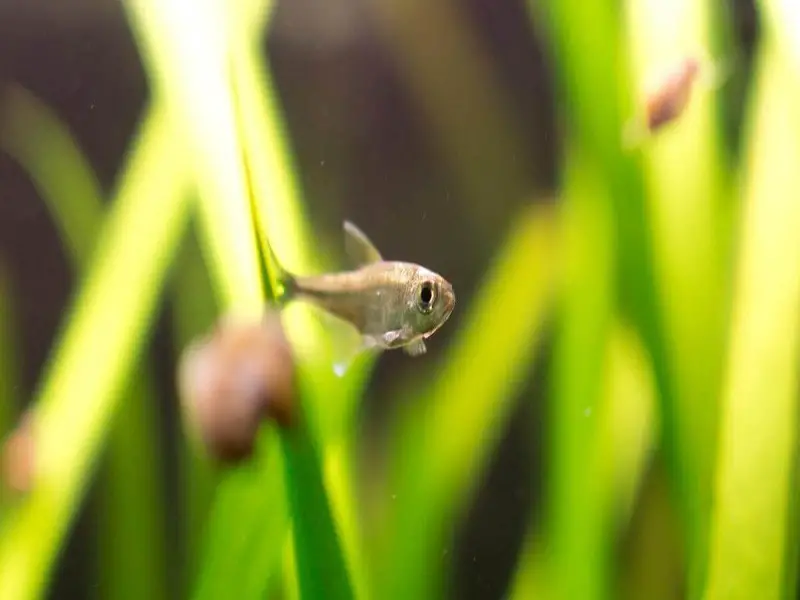
Aquarium fish always do better when you can recreate their natural habitat. Even fish that are bred in captivity appreciate the conditions of the wild, even if they have never seen them before. In their natural habitat, Gold Tetras enjoy slow-moving, brackish water. Providing these conditions for your Gold Tetras will result in optimal well-being for your fish.
In terms of the aquascape, Gold Tetras do well with a substrate of sand, as they enjoy in the wild. Don’t skimp on the driftwood and dried leaves; they like to find adventures around the wooded area, and the leaves and driftwood also release tannins that will tint the water, making it more acidic and also making the Gold Tetras feel safer.
Pro tip: The dried leaves will have to be changed out every few weeks so that they don’t get rotten and dirty the tank.
You will need a water filter to keep the tank clean, but remember that they are accustomed to slow-moving waters, so be careful that the filter you choose does not create a strong current. If the water does seem too fast, you can add a plant or decoration in front of the filter to diffuse the current.
You could also add some peat (aquarium safe) to the filter to create the water tint. Speaking of tint, Gold Tetras prefer a dimly lit tank, so don’t get an artificial light that is too strong, and watch for the light sources, natural and artificial, that are surrounding the tank.
While plants are not in the Gold Tetra’s natural environment, they can help filter the light and also add to the aesthetic of the aquarium.
Water Conditions
You should do a 50% water change every other week in order to keep the tank impeccably clean. Gold Tetras like warm, soft, and acidic water.
The optimal parameters to ensure the best quality of life for Gold Tetras:
- pH levels: 5.5-7.0
- Water hardness: 3-8 dKH
- Water temperature: 77 °F to 82.4°F (25° to 28° C)
What Size Aquarium Do They Need?
I recommend at least a 20-gallon tank. Although Gold Tetras are small, they need to be kept in groups of at least 6, so you need enough space for the group to swim around comfortably; if there are other fish in the community aquarium, you’ll have to go larger.
How Many Can Be Kept Per Gallon?
You could keep 6 Gold Tetras in a 20-gallon tank. If you have a larger shoal, you could try a 30-gallon tank.
Tank Mates
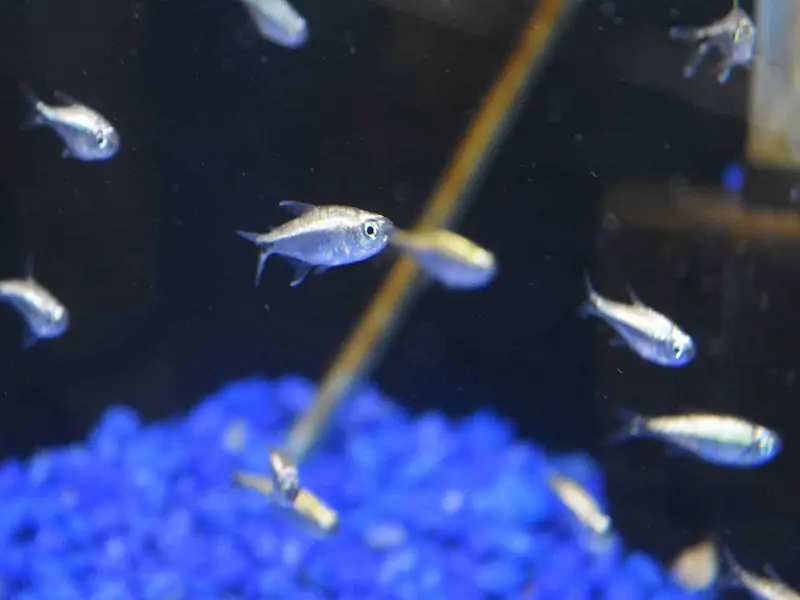
Gold Tetras do well with other peaceful fish. Avoid pairing them with high-energy fish that will stress them out, and don’t choose tank mates that are much larger than they are.
You’ll also want to choose tank mates that prefer the same type of soft, warm, acidic water.
Suitable Tankmates
- Barbs
- Corydoras Catfish
- Danios
- Dojo Loach
- Dwarf Cichlids
- Hatchetfish
- Hillstream Loaches
- Kuhli Loach
- Other Peaceful Tetras
- Pencilfish
- Rasbora
- Smaller Suckermouth Catfish
Keeping Gold Tetras Together
Gold Tetra are shoaling fish and must be kept in groups. I would recommend a minimum of 6, but you could go for a larger group, too.
Diet
High-quality food is important for Gold Tetras. They are omnivores, so they need a combination of greens and protein to complete a varied diet. They will happily eat tropical flakes and pellets, but you should supplement with spirulina for greens and blackworms, bloodworms, brine shrimp, and daphnia for animal protein.
Make sure you’re not overfeeding them by giving only what they can eat in about 3 minutes. If they eat too much, they will get bloated, and you’ll just have to clean the water more often as more consumption equals more waste.
Care
Like all freshwater fish, Gold Tetras are susceptible to parasitic, bacterial, and viral infections. Therefore, the key to Gold Tetra care is the elimination of stress: clean water, proper water parameters, good friends, a healthy diet, and a soothing habitat.
Stress increases the Gold Tetra’s chances of getting sick–just like humans! Providing an environment where they can enjoy a life of minimal stress will do much to prevent disease. Clean water prevents disease in two ways; not only does it reduce stress but it also reduces the harmful bacteria and parasites present in the water source.
Keeping the correct water parameters (discussed above) also reduces stress, as temperatures that are too hot or too cold, pH levels that are too acidic or too alkaline, or water that is too hard or too soft places physical stress on your fish. Gold Tetras need warm, acidic, and soft water.
Another stress buster is making sure they are surrounded by friends. Gold Tetras are shoaling fish and should be in a group of at least 6, which will ensure that they feel happy and safe.
A balanced diet is also important (think about how stressed out you feel if you’re on a sugar rush or eat too much-fried food!) Gold Tetras need high-quality food that has a balance of green and protein.
Finally, providing an appealing aquascape helps reduce stress; calm is encouraged by recreating their natural environment. Adding some driftwood and plants will make them happy and provide hiding places to make them feel secure.
Certainly, stress cannot be completely eliminated, and clean water will not protect your Gold Tetras from every malady. In fact, Gold Tetras are more susceptible to disease than much other freshwater fish. Two of the most common include:
Ich: Ich (also known as Ick or White Spot Disease) is a very common parasitic disease found in freshwater aquariums. It comes from a ciliate parasite whose presence is revealed through the visible white spots it leaves on your fish.
Ich can be fatal if not treated promptly, and it reproduces very quickly. You should treat with a dedicated Ich medicine as soon as possible. Be aware that most Ich medications contain copper, which can be harmful to some of your aquarium residents.
Skin Flukes: Skin or gill flukes are also really common in freshwater aquariums. Flukes are caused by parasites that look like worms with hooks; those hooks are how they attach to the fish’s skin, interfering with their ability to take in oxygen. Additionally, the holes created by the hooks can lead to secondary bacterial infections.
Pro tip: Because Gold Tetras are so susceptible to diseases, you can often catch the presence of disease early enough to treat if you monitor them closely. They could be the saviors of your tank!
The Importance of Quarantine
Anyone and anything can bring fungus, parasites, and bacteria into your home aquarium. Because these diseases spread so quickly, your happy aquarium home can soon be overrun with life-threatening risks to your beloved aquatic friends.
I highly recommend that you save yourself and your pets a lot of headache by quarantining any new arrivals. Whether it is a new Gold Tetra, a plant, a piece of wood, or a store-bought cave, quarantine for two weeks before adding to your community tank.
Even the most investigative eyes will miss some of these tiny creatures or their eggs, which can lead to a rapid and out-of-control infestation.
Breeding
Gold Tetras lay eggs, and it’s fairly easy to breed them in a home tank, although you will need a dedicated breeding tank. Said breeding tank should be at least 10 gallons and populated with an equal number of males and females–6 of each sex is a good measure.
You should stock the tank with green plants and/or floss on which the females can lay their eggs. Other than that, you won’t need to do anything special to encourage reproduction. The special breeding tank is mainly to protect the fry.
It should be noted, however, that for optimal spawning, Gold Tetras prefer soft water, with a pH of about 6.0, and warm water, about 80° F (26.7 ° C).
Pro tip: Gold Tetra Fry get their rich color from the special defense mechanism that is produced to protect them from the parasites they are at risk from in the wild. Your fry that is bred at home will likely not have the gold tone.
After the eggs are fertilized, the males and females should be removed from the breeding tank. In less than 24 hours, the eggs will start hatching, and the fry will be happily swimming in a few days. Until they can handle brine shrimp and micro worms, feed the fry infusoria.
Pro tip: Because Gold Tetra fry is sensitive to light, you should try to keep the tank as dark as possible. Keep the breeding tank in a spot that is out of the range of direct sunlight.
Are Gold Tetras Suitable for your Aquarium?
Gold Tetras are a great choice for a community aquarium: they are not difficult to care for and are survivors. As long as the water is kept clean, advanced beginners should be able to have success in raising Gold Tetras.
Additionally, they’re easy enough to breed if you have a separate breeding tank. While their care doesn’t require advanced skills, Gold Tetras will still hold the attention of seasoned aquarists.
Do you have experience with Gold Tetras that you’d like to share with others? Do you have more questions about Gold Tetras? We’d love to hear from you in the comments section below.
FAQ
What is the average lifespan for Gold Tetras?
In captivity, you can expect your Gold Tetras to live for 3-4 years, assuming they get great care and are not in a community tank with larger or more aggressive fish.
I’m just starting my fish-keeping hobby. Would these fish be a good choice?
While Gold Tetra care is not excessively difficult, I would not recommend these fish for an absolute beginner. They have lower immune systems than many other aquarium fish and are more likely to contract skin diseases.
I would wait until you have treated a round of ich or flukes on other fish before graduating to a Gold Tetra shoal.
Are my Gold Tetras vegetarian? They are so small; I can’t imagine them eating meat.
That’s a great question. Gold Tetras are omnivores, so they require a combination of vegetable and animal matter. However, it’s not the kind of meat you would expect. Small animal proteins from blackworms, bloodworms, brine shrimp, and daphnia will satisfy their meat needs.
Do I need to have a separate breeding tank for Gold Tetras?
Yes. I recommend a 10-gallon breeding tank. As soon as the eggs are fertilized, you should remove the parent fish and feed the fry until they are large enough to add the community tank.
I have limited space for my aquarium. Are Gold Tetras a good fit for a smaller aquarium?
You will need a 20-gallon tank to house a shoal of Gold Tetras. Some people get away with 15 gallons, but I personally do not think that’s fair to the fish, who need room to swim around. So while you don’t need a 70-gallon tank for these little fish, a 5-gallon micro tank is not going to work, either.
You might think you could get away with a micro tank and just get 1 or 2 Gold Tetras, but I discourage you from doing that. Gold Tetras are not going to thrive if they are not in a group of at least 6. They will be stressed out and anxious–the group makes them feel secure.
With only one or a pair, your Gold Tetra(s) will be at an increased risk for disease. You’ll also see the difference in their color, which will be duller, and they will likely not live their 3 to 4-year lifespan.
Do I need to add a filter to the tank for Gold Tetras?
I definitely recommend a filter in any tank where you are raising Gold Tetras. Because they are more prone to skin infections and disease, you need to be sure to keep the water as clean as possible, and one way to do this is to keep the water filtered.
(You should also be cleaning with regular 50 percent water changes every other week.)
When choosing a filter, select one that is not too strong. This is because Gold Tetras are accustomed to slow-moving water, and a strong filter will create a current that might move the water too quickly and forcefully for the Gold Tetras. Let’s face it: Gold Tetras are not the most adept swimmers, and besides, they are slow.
Too strong a water current will stress them out and cause negative physical effects. If you do find that the filter you have chosen is too strong, try strategically placing a plant or decoration in front of the filter to diffuse the current.
Should I put plants in my Gold Tetra aquarium?
Although Gold Tetras do not have lush plant life in their natural habitat, I do recommend adding some plants, particularly floating ones, to the aquascape.
Gold Tetras are very shy, and they will appreciate extra places to hide. You definitely don’t want to skip the driftwood that is their go-to refuge, but plants provide some extra cover.
Additionally, the plants will filter out and diffuse some of the light that can shine into the tank. Gold Tetras are sensitive to bright light and prefer a dim environment, and plants can help with this.

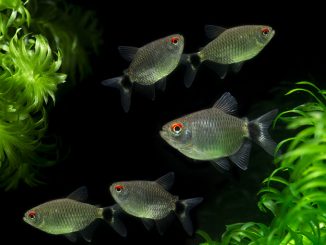
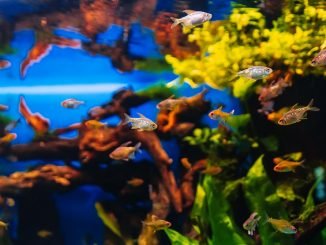
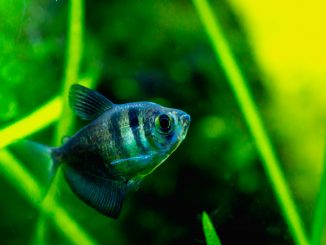
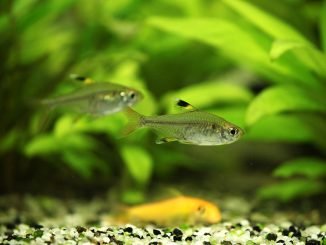
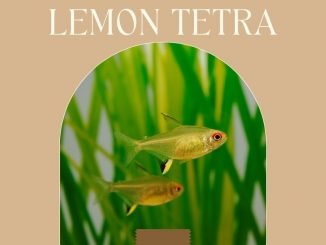

Be the first to comment